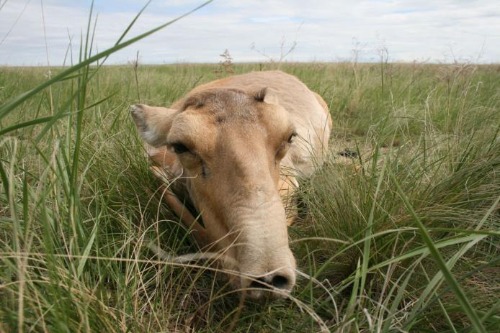New NERC grant: Saiga antelope mortality in Kazakhstan 2015: emergency investigation of disease outbreak to improve knowledge of drivers
Professor Richard Kock has received a grant from Natural Environment Research Council for the following study: "Saiga antelope mortality in Kazakhstan 2015: emergency investigation of disease outbreak to improve knowledge of drivers"
Between 10th and 27th May 2015, officially an estimated ~134,000 saiga antelopes (Saiga tatarica tatarica) died from a per-acute disease event which occurred in up to 14 discrete sites in central Kazakhstan. Two sub-populations in Kazakhstan in Uralsk and Utsiurt and others in Mongolia and Russia were unaffected by this syndrome. The die-off groups were clustered in aggregations some tens of kilometres apart in 3 sub-sectors about 250 km apart and two smaller aggregations. This highly unusual event appears to be a result of a complex interplay between landscape-scale environmental factors and highly virulent pathogen(s), latent in adult animals, but as yet the contributing factors are unknown.
These die-off events have been recorded before in this population, intermittently since the 1950s. Kazakh government sponsored annual monitoring programmes at saiga calving sites started in 2013 after advice from UNEP Convention in Migratory Species (CMS), FAO and Royal Veterinary College (RVC) and with increasing technical support and training. This initiative was in response to international engagement on the 2010 and 2011 saiga disease outbreaks in Uralsk and it comprises a joint team from ACBK, RIBSP RVC and rangers from the Okhotzooprom. This ensured that two die-off events, occurring approximately a week apart in May 2015 in Turgay (~60000 saiga) and Tengiz (~8500 saiga) were intensely monitored. The location in Turgay was within 20 km of the aggregation monitored in 2014 by the same teams.
The findings from these outbreak investigation teams and initial diagnostics were reported to the committee of the responsible Ministry set up to investigate and coordinate response to the die-off in late May and this was also reported to UNEP contributing to the emergency response. Since this time further diagnostics on samples were performed and this process is ongoing. A second mission was launched to follow the migration routes and die off sites to undertake further environmental sampling including soil, vegetation and water and any unusual wildlife and livestock mortalities or other observations and histories recorded.
The initial diagnosis in adults based on microbiology (independently verified in 3 laboratories) and gross pathology undertaken by the RIBSP and RVC (and proximate cause of death) is haemorrhagic septicaemia due to infection with a hypervirulent form of the latent commensal parasite Pasteurella multocida serotype B. Hypervirulence most probably triggered by some priming or environmental factor intra- or extra-host in the general region where the aggregations occurred. There was also probable clostridial opportunistic superinfection of the gastrointestinal tract in a significant number of saiga with release of alpha toxins, absorbed and contributing to the general toxicology of this per-acute disease. Although other pathogens have been detected including viruses and blood parasites their role is not currently determined and tests are ongoing.
The outcome from the post outbreak mission suggests highly variable vegetation characteristics across the die-off sites. This suggests it is unlikely that any single plant species or vegetation factor is involved although fungal or other environmental contaminants or toxins that could be absorbed into the plants more generally cannot be ruled out. The enormous landscape involved also reduces the likelihood of water sourced toxins or pollutants in general, unless acquired immediately before the disease through some remarkable global deposition associated with the heavy rainfall and flooding reported. Further virus screening, toxicology and detailed histopathology is pending and should be undertaken in appropriate international reference laboratories and institutions Certain other peracute infectious diseases have been ruled out including anthrax. The epidemiology does not support a classical directly transmitted infectious disease amongst the adult population (although possible in the calves). Mosquitos were superabundant during the die off so a vector borne disease with a high reproductive rate is theoretically possible but unlikely, when taking incubation periods into account.
The most credible explanation for the disease is the sudden hypervirulent emergence of a latent infection with a common environmental trigger.

In this project the researchers will analyse materials collected during monitoring of the die offs which was carried out between 9th – 28th May; carry out gap-filling fieldwork to collect additional data; produce a review of the evidence around past, current and potential future mass mortality events in the species; and engage with governments, international bodies and other interested parties to agree surveillance and response protocols for future outbreaks. This is urgently needed because although a proximate cause of death, due to polymicrobial opportunistic infection consistent with HS and clostridiosis, is now reasonably supported by the evidence, the trigger or priming factors for this remarkable and synchronous event, across a vast landscape, affecting the majority of living saiga in the region remains unknown. To address this complexity, a multi-disciplinary team is required to capture and analyse data from these outbreaks, relating to the host, pathogens/toxins and environment.
The objectives of the study are:
a) comprehensively analyse already-collected materials both in country and at international reference laboratories and specialist institutions,
b) carry out targeted field expeditions to collect supplementary information,
c) carry out an inter-disciplinary evidence review, d) Contribute to governmental and international policy and action.
Professor Kock from the Department of Pathology and Pathogen Biology and RVC research assistant/PhD candidate Wendy Beauvais from the Department of Veterinary Epidemiology, Economics and Public Health will be working with researchers from Imperial College and Bristol University as well as Research Institute for Biological Safety Problems, Swedish University of Agricultural Sciences, Association for the Conservation of Biodiversity in Kazakhstan, Convention on Migratory Species, Fauna & Flora International (FFI) and Food and Agriculture Organisation
You may also be interested in:
-
The RVC’s Professor Joanne Webster awarded Royal Society medal
Joanne Webster FMedSci, Professor of Parasitic Diseases at the Royal Veterinary College (RVC), has …

